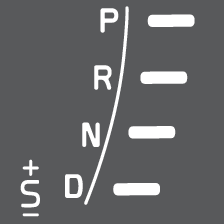
Combined instrument panel shows the position of the gear selector using the following indications: P, R, N, D, S*, 1, 2, 3 etc.
Gear positions

Automatic gear positions are indicated on the right of the combined instrument panel. (Only one marker is illuminated at a time - the one showing the current gear selector position.)
Parking position - P
Select P position when starting the engine or when the car is parked.
In order to be able to move the gear selector from the P position, the brake pedal must be depressed and key position must be II, see Key positions - functions at different levels.
Note
The gearbox is mechanically blocked when the P position is engaged. Also apply the parking brake when the car is parked.
Note
Important
Warning
Reverse position - R
The car must be stationary when R position is selected.
Neutral position - N
No gear is engaged and the engine can be started. Apply the parking brake if the car is stationary with the gear selector in N position.
In order to be able to move the gear selector from N to another gear position, the brake pedal must be depressed and key position must be II, see Key positions - functions at different levels.
Drive position - D
D is the normal driving position. Shifting up and down takes place automatically based on the level of acceleration and speed. The car must be stationary when the gear selector is moved to D position from R position.
Geartronic – Manual gear positions (+S-)
With the gear selector in manual gear position "+S-" the internal combustion engine is permanently in operation. The driver must then change manually and the car engine brakes when the accelerator pedal is released.

The manual gear position is reached by moving the lever to the side from position D to the end position at "+S-". The combined instrument panel's symbol "+S-" changes colour from WHITE to ORANGE and the digits 1, 2, 3 etc. are displayed in a box, corresponding to the gear that has just been selected.
- Move the lever forwards towards "+" (plus) to change up a gear and release the lever, which returns to its rest position between + and –.
or
- Pull the lever back towards "–" (minus) to change down a gear and release it.
The manual gearshift mode "+S–" can be selected at any time while driving.
Geartronic automatically shifts down if the driver allows the speed to decrease lower than a level suitable for the selected gear, in order to avoid jerking and stalling.
To return to automatic driving mode:
- Move the lever to the side to the end position at D.
Geartronic - Winter mode
It can be easier to pull away on slippery roads if 3rd gear is engaged manually.
- Depress the brake pedal and move the gear selector from D position to the end position at "+S–" - the combined instrument panel changes indication from D to the figure 1.
- Scroll up to gear 3 by pushing the lever forward towards "+" (plus) twice - the display shifts the indication from 1 to 3.
- Release the brake and accelerate carefully.
The gearbox "winter mode" means that the car moves off with a lower engine speed and reduced engine power on the drive wheels.
Kick-down
When the accelerator pedal is pressed all the way to the floor (beyond the position normally regarded as full acceleration) a lower gear is immediately engaged. This is known as kick-down.
If the accelerator is released from the kick-down position, the gearbox automatically changes up.
Kick-down is used when maximum acceleration is needed, such as for overtaking.
Safety function
To prevent overrevving the engine, the gearbox control program has a protective downshift inhibitor which prevents the kick-down function.
Geartronic does not permit downshifting/kick-down which would result in an engine speed high enough to damage the engine. Nothing happens if the driver still tries to shift down in this way at high engine speed – the original gear remains engaged.
When kick-down is activated the car can change one or more gears at a time depending on engine speed. The car changes up when the engine reaches its maximum speed in order to prevent damage to the engine.
Towing
If the car has to be towed - see important information in the section Towing.